I received Zidoo M6 last month, a mini PC based on Rockchip RK3566 quad-core Cortex-A55 processor. I initially understood it came with Ubuntu Linux, but actually, it came pre-loaded with Android 11, so I’ve decided to run some benchmarks on the RK3566 device to see how it performs compared to other Arm systems
Zidoo M6 system info
But before running benchmarks, let’s have a look at some system info with CPU-Z
CPU-Z has never heard about RK3566, so it detects it as RK3066, but the rest of the information seems correct with a quad-core Cortex-A55 clocked between 400 MHz and 1.8 GHz, an Arm Mali-G52 GPU, 3775KB RAM, and 24.12 GB internal storage from the 32GB flash. The system runs Android 11 on top of Linux 4.19 which will be supported until December 2024. I can set the video output to 4K, but the UI is still limited to 1920×1080 as expected for this type of system. The temperature reported in CPU-Z is meaningless with a room temperature of about 28 to 30°C. Root access is set to “no”, but I had no problem get root access through adb when I registered the device to get rid of the Play Protect error message.
Rockchip RK3566 Benchmarks
Historically, I’ve been using three benchmarks in Android TV boxes: Antutu, Vellamo, and 3Dmark. But Vellamo has been deprecated for a few years now, Antutu has been removed from the Google Play store, and 3DMark will refuse to run on the device. So I had to find alternatives starting with Geekbench 5.0.
You’ll find the detailed results on the Geekbench website. It’s interesting to compare it to the Amlogic S905X4 quad-core Cortex-A55 processor, and the results are similar except for some exceptions such as the navigation score that is 1.76 times (single core) and 2.54 times (multi-threaded) faster on the Amlogic processor.
GeekBench explains the Navigation workload as follows:
The Navigation workload computes driving directions between a sequence of destinations using Dijkstra’s algorithm. Similar techniques are used to compute paths in games, to route computer network traffic, and to route driving directions. The dataset contains 216,548 nodes and 450,277 edges with weights approximating travel time along the road represented by the edge. The route includes 13 destinations. The dataset is based on Open Street Map data for Ontario, Canada.
It’s unclear what causes the significant difference. One might think it could be related to memory bandwidth with a large dataset, but Zidoo M6 comes with LPDDR4.
I could not install PCMark and 3DMark, but was unable to run any benchmarks as clicking on the Run button did not trigger any actions. I contact UL who told me to manually install the APL and DLC “workload” files, but the result was the same. So instead, I went with Passmark PerformanceTest Mobile for Android.
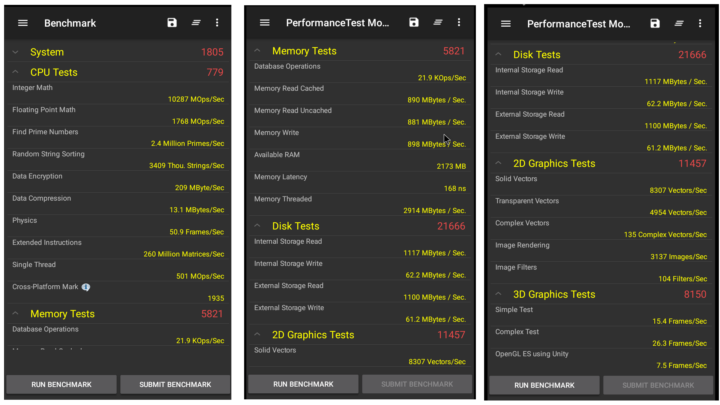 I ran the test twice with 1805 points the first time, and 1850 points the second time which puts it right at the level of a Samsung Galaxy Tab A 10.5-inch with a Qualcomm Snapdragon 450 octa-core Cortex A53 processor @ 1.8GHz.
I ran the test twice with 1805 points the first time, and 1850 points the second time which puts it right at the level of a Samsung Galaxy Tab A 10.5-inch with a Qualcomm Snapdragon 450 octa-core Cortex A53 processor @ 1.8GHz.
I finally decided to sideload Antutu since I did not have that much data to play with. Antutu 9.0 Beta is the version currently available on the website.
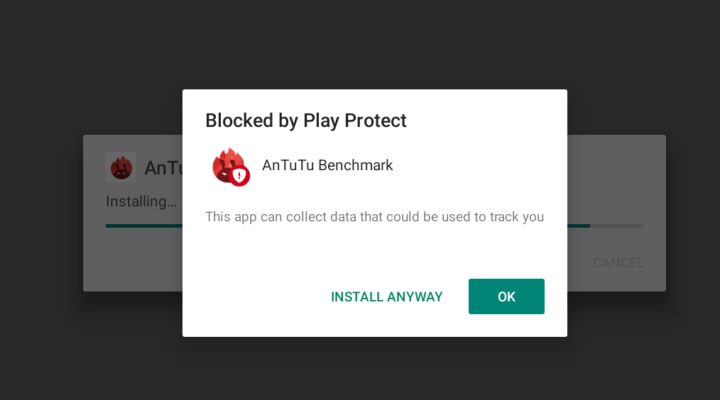 The reason the app was kicked from the Play store is probably related to privacy, as we are warned the app can collect data that could be used for tracking purposes. I could install the app, but it would keep on trying to download the Antutu 3DBench from the Play store, even though I sideloaded it already so I was unable to run Antutu benchmark on Zidoo M6.
The reason the app was kicked from the Play store is probably related to privacy, as we are warned the app can collect data that could be used for tracking purposes. I could install the app, but it would keep on trying to download the Antutu 3DBench from the Play store, even though I sideloaded it already so I was unable to run Antutu benchmark on Zidoo M6.
Zidoo told me they could run Antutu 6.0.2, so I installed the apks for the main benchmark and 3D benchmark and could get some results.
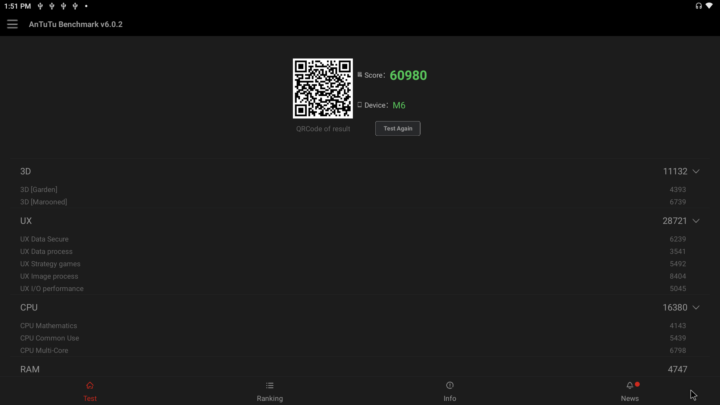 This Antutu version is fairly old, so the link associated with the QR code does not work. But that’s not a problem as I’ve got Antutu 6 numbers for S905X, RK3328, and H6 which can provide a comparison base. Android has been optimized over the years, and newer versions may yield a slightly higher benchmarks score, but it still give an idea. Allwinner H6 is a quad-core Cortex-A53 clocked at up to 1.8 GHz got 40,467 points in the same Antutu 6 benchmark, meaning Rockchip RK3566 overall score is about 50% higher. Looking into details, we can see the CPU score is roughly equivalent (16,380 vs 16,395), but the Mali-G52 really shines in comparison, getting 11132 points against 6,292 points (H6 with Mali-720 GPU) in the 3D benchmark. The UX score is also much higher (28721 vs 13,360), while the RAM score is quite marginally higher for RK3566 (4747 vs 4,420).
This Antutu version is fairly old, so the link associated with the QR code does not work. But that’s not a problem as I’ve got Antutu 6 numbers for S905X, RK3328, and H6 which can provide a comparison base. Android has been optimized over the years, and newer versions may yield a slightly higher benchmarks score, but it still give an idea. Allwinner H6 is a quad-core Cortex-A53 clocked at up to 1.8 GHz got 40,467 points in the same Antutu 6 benchmark, meaning Rockchip RK3566 overall score is about 50% higher. Looking into details, we can see the CPU score is roughly equivalent (16,380 vs 16,395), but the Mali-G52 really shines in comparison, getting 11132 points against 6,292 points (H6 with Mali-720 GPU) in the 3D benchmark. The UX score is also much higher (28721 vs 13,360), while the RAM score is quite marginally higher for RK3566 (4747 vs 4,420).

Jean-Luc started CNX Software in 2010 as a part-time endeavor, before quitting his job as a software engineering manager, and starting to write daily news, and reviews full time later in 2011.
Support CNX Software! Donate via cryptocurrencies, become a Patron on Patreon, or purchase goods on Amazon or Aliexpress


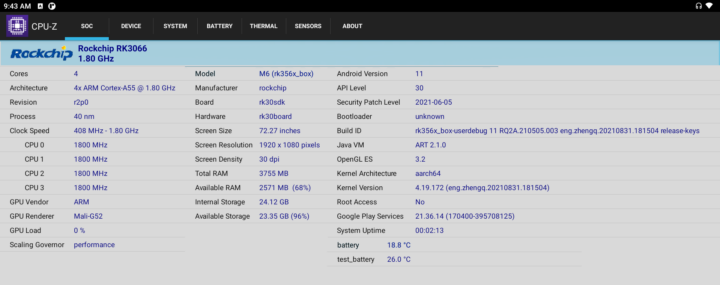
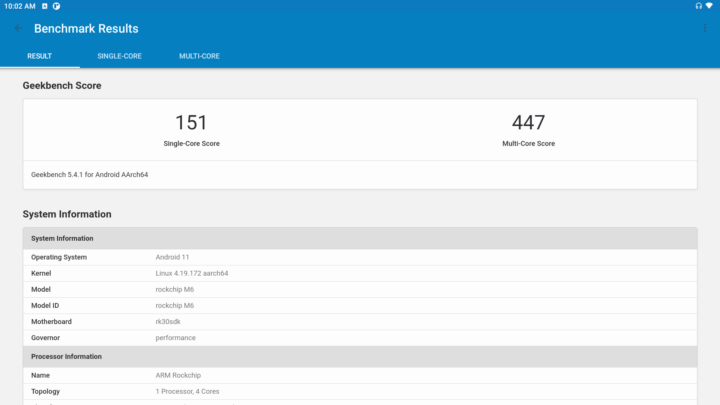
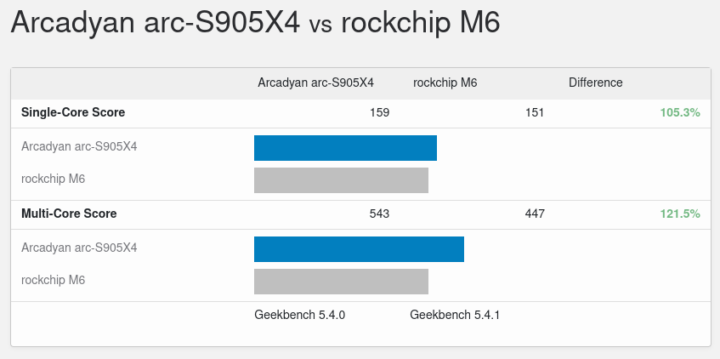



Good review, thank you.
Wow, that is a lot of software that you can’t install or use
Yes, Android 11 on RK3566 looks to be work-in-progress…